-
Posts
719 -
Joined
-
Last visited
-
Days Won
13
Content Type
Profiles
Forums
Events
Store
Downloads
Gallery
Posts posted by GRC
-
-
like Barry, I'm also a science teacher (although not retired yet).
I just wanted to comment on a few little statements to maybe help a bit, and avoid having some members (without science backgrounds) build up some accidental misconceptions

Ford just corrected this one, perhaps inadvertently. silver sufide vs silver sulphate:
The black silver "tarnish" that you see building up on old silver is Ag2S, is called silver sulfide, not "silver sulfate" Ag2(SO4) (silver sulphate for the UK spellers out their). These are two different substances with different physical and chemical properties. For example: silver sulfide is black, whereas silver sulfate is white.
23 hours ago, mas4t0 said:Silver Sulphate is very slightly soluble in aqueous solution (i.e. where water is the solvent) so there would be some losses into the solution.
Silver sulfide forms a covalently bonded "network solid" with only slight ionic properties, and is considered to be insoluble in most solvents, including water. (https://en.wikipedia.org/wiki/Silver_sulfide)

ie. It doesn't dissolve much at all, in just about any type of substance that would dissolve other things, so the loss in water would be pretty much imperceptible.
Just some semantic wording on this one, but I believe the ideas are fundamentally sound when taken together as a whole:
21 hours ago, ROKUJURO said:an element gains weight when it reacts with another one. Iron with a given net weight will be a bit heavier when rust forms on the surface. Removing the rust (and I don't mean with an angle grinder!) will reduce the basic weight of the iron.
The main thing to clarify is the use of the word "element".
The word "element" gets muddied by the fact that it can be used to refer to a single atom (like 1 atom of silver) or a grouping of atoms of 1 type (like a block of 100% pure silver).
It might be more clear to rewrite it like this (although much wordier... so it's always a pain in the butt to explain science clearly in a chat or forum-post format):
A metal object will gain weight when the surface atoms react with other elements/compounds in such a way to produce some type of "corrosion product", but only if that "corrosion product" stays on the surface of the metal object.
The reason for this weight gain is that atoms from an external source in the environment are reacting with the surface atoms of the metal object in such a way as to combine with them to form "compounds". ie New atoms are being added to the metal object, therefore the object will gain the additional weight of the new atoms. That's the whole "conservation of mass" concept that was stated earlier by Mark H.
Now on to the use of "element" in the context of weight changes:
A block of "elemental" pure silver, will gain mass when it tarnishes, because sulfur atoms are being added to its surface as the black tarnish forms.
But, technically an "element" as a "single atom" doesn't necessarily gain weight in a reaction...
If an element ("single atom") does change weight in a chemical reaction, the atom itself will have only gained, lost or shared electrons, which are so small in size and mass that they are not measurable on a practical level.
In the case of silver tarnish, a single atom of silver will be constantly gaining and losing the two electrons that are now being shared in the covalent bond between it and an the adjacent sulfur atom in the silver sulfide network. One silver and one sulfur are now sharing one electron each with each other, and these two electrons will be travelling (teleporting) back and forth between the adjacent silver and sulfur atoms. And again, this gain and loss of electrons would be imperceptible on any practical level of measurement.
Now back to Colin's tsuba and iron corrosion products:
In some cases the corrosion products (like the iron oxides in Colin's tsuba) have different physical properties that the original metal object, making them structurally more brittle, which can allow them to "break away" from the metal object over time. In the case of Colin's tsuba, the pitting we see is caused by the loss of this more flaky, brittle, iron oxide material ("rust").
So this tsuba has definitely lost some weight that could easily be measured (if we had the original mass).
But if there is simply some reddish dusting on the surface of a steel tsuba, and none of it has flaked off yet, then the steel tsuba will have also gained weight, similar to the way the silver tarnish added weight to a block of silver. However, In this case, oxygen atoms will have been added to its surface as it "rusted" to form the iron oxides.
Tying the idea of change in properties back to silver tarnish:
The fact silver sulfide that it forms a "network solid" helps explain Ford's observations that it can actually flake off in chunks on really old silver.
I've never seen that, but unlike Ford, I've never had a piece of silver that was so old that it had built up enough of this solid silver sulfide.
Cool "fun facts" for the classroom, thanks Ford.

Effects of rust or tarnish removal on weight:
So given all of the above information, any time you polish away the rust from steel or tarnish from silver, you will be physically removing some of the original iron or silver atoms that had been incorporated into the rust or tarnish that you are removing.
Ok i'm done now... sorry for being so long winded

I hope it helps.
-
 2
2
-
-
Thanks Geraint, it was actually Dale's post of exactly that set that got me thinking about all those questions

That Nanban set was likely made in Japan, possibly by Chinese smiths working in Nagasaki.
-
 1
1
-
-
One of Dale's posts in the "Unaltered Nanban" thread got me thinking...
I've got some questions related to kozuka and kogai (not my area of focus, so I don't know too much about them):
1- Given that these are both Japanese implements, could one assume that "ALL" kozuka and kogai were made in Japan?
2- Does anyone have any examples of kogai or kozuka that were made in another country (other than cheapo modern knock-offs)?
3- Does anyone have any examples of kogai or kozuka that were fitted and used on non-Japanese swords?
4a- What do the earliest (pre-Edo to early Edo) kozuka and kogai look like?
4b- Were early kogai and kozuka entirely made of steel, or was the use of soft metals present from the beginning?
4c- Was the kozuka ever done with a one piece construction, or was the kozuka always made separately from the kogatana?
Thanks in advance to anyone who can help fill in some of these details

My apologies for the barrage of questions... but I would suggest placing the blame on Dale for making me wonder all this

-
 1
1
-
-
Thanks for posting that Dale,
Mandarinmansion is a fantastic resource for Nanban related content and information.

I have never seen another set of Kozuka and Kogai like those before.
Both are carved from a single piece of steel too, which seems to be genuinely "unique" (or at least extremely rare) for the kozuka, which typically "always" have a separate kogatana blade inserted into the kozuka handle.
1 hour ago, Spartancrest said:Now where were these made?
The tsuba on the left:
Japanese features: Japanese style twin dragon motif; an ovoid Japanese seppa-dai; and purposeful hitsu-ana outlined by the dragon claw and cloud; also mokko shapes are not very common among the nanban tsuba and is generally a more common shape among Japanese tsuba.
Chinese features: has only 2 directional cross hatching for the nunome; the piercings are mostly just drilled through holes with very little shaping and no undercutting to make a more 3D web.
The combination of these seemingly contradictory features suggest a Chinese smith living and working in Japan, like in the "Chinatown" area of Nagasaki, producing tsuba for the Japanese market.
I noticed the website's caption under the image also stated "Nagasaki" as the probably location

The tsuba on the right:
100% Chinese: 2 way cross-hatching, Chinese style dragons; stylized Chinese Song-shan mountain motif below the seppa-dai; Chinese seppa-dai; no hitsu-ana; tsuba is bordered around the outside by a circle of lotus petals; the squared-round shape of the tsuba; the piercings are a bit rough and not meticulously undercut.
Kogai & Kozuka set:
It has more in keeping with the dragon style and production cues of the tsuba on the left, so Nagasaki area makes the most sense for these as well.
-
Roger, I think yours is a variation on the wan-gata form that was more common in continental Asia, but also produced in lower numbers by a variety of schools in Japan.
But at the same time, like Dale suggested, it could looks like a variant of the Japanese Uchikaeshimimi form which not typically dished like a wan-gata... so yours looks like a blend of aesthetics.
I have seen several examples of wan-gata shaped "Hizen", nunome decorated tsuba, where the dished inward side is much rougher than the outer surface.
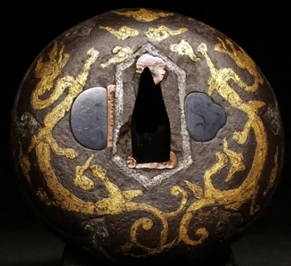
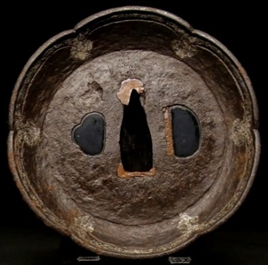
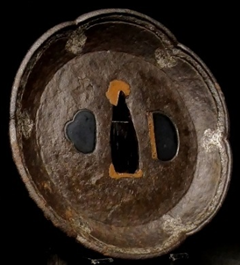
Although that's not always the case...
Here's one (Possibly of Korean origin) that is finished smooth on both surfaces:
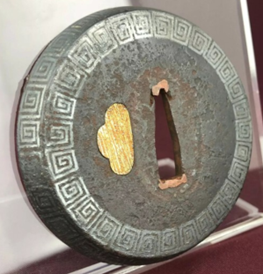
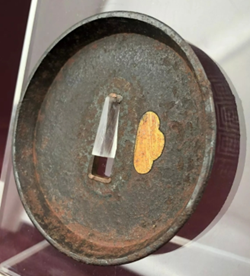
Given that both rough and smooth inner surfaces exist on the dished wan-gata forms, you would have to conclude that it was a deliberate choice by the smith to leave one side rough.
And Roger, yours has deliberate horizontal chisel marks that were done in clusters.
I think they are meant to suggest some form of "mist" or "air" to go along with the dragon on the front.
-
 1
1
-
 1
1
-
-
Does anyone have any other examples of this style of Nanban tsuba?
I can say with certainty that these were made in Japan for the Japanese market, but I have no idea by whom or where specifically.
Both appear to be unaltered (other than maybe the width of the nakago-ana, and the addition of sekigane on the second one)
They must be from the same "school" and probably even the same smith, but that's all I have found so far of this type...
I'm wondering if there even was a whole "school" of smiths producing this style, or if the smith was an "independent" Edo period smith.
EXAMPLE 1:
EXAMPLE 2:
-
 1
1
-
 2
2
-
-
Another nice one Bruno,
Looks more like an Edo period piece because of the tsuba's shape, the heavy thickness, and the pretty good condition of the nunome.
However, the tsuba has been around long enough to have been mounted at least twice (there's a "double sekigane" at the top of the nakago-ana).
It's definitely made for the Japanese market and likely made in Japan (I would assume somewhere in the Hizen area):
The hitsu-ana appear to be original to the tsuba, or at least they were present before the application of the nunome.
The nunome design also properly contours the hitsu-ana, rather than being cut through by a "later modified nakago-ana".
I can't tell what the arcing design motifs are in the four corners on the ura side...
Any idea what they might be Bruno?
-
 1
1
-
-
Bruno, that's a nice example of a Kiyou Toujin tsuba (is it yours?)
Dale, definitely from the same school. They did a lot of "phoenix" and dragon combinations
-
Here are some examples of what appear to be Japanese-made Katchushi and Tosho style tsuba which have added nanban nunome (overlay) patterns.
I can think of three possible explanations:
1- These could have been Muromachi period Japanese exports, that were decorated in continental Asia for use there, then ended up back in Japan at some point.
2- They could have been made entirely in continental Asia, and they just copied the Japanese Katchushi and Tosho tsuba shapes.
3- They could have been "decorated" at one of the ports like Hizen (possibly even at a much later date than the production of the tsuba plate itself).
There's no way to know for sure though...
It's also possible that all three hypotheses are correct, resulting in multiple avenues for producing a similar outcome, and making it really difficult to pin down any one of these "histories" on any particular tsuba.
The top and bottom pair of images show the omote and ura faces of one specific tsuba. It's interesting to note the difference in the treatment of the nunome outline of the seppa-dai on the opposing faces of the tsuba.
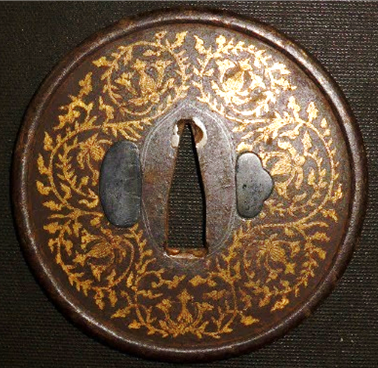
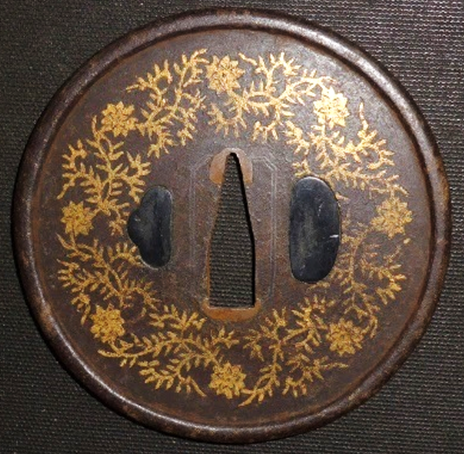
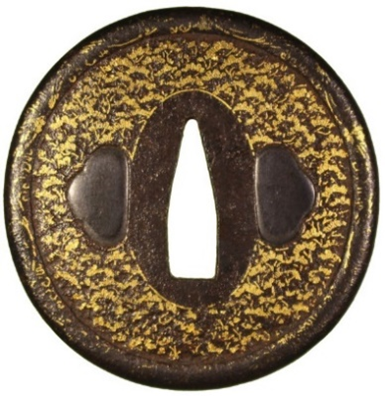
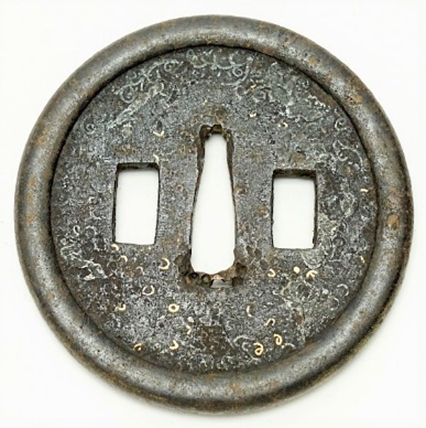
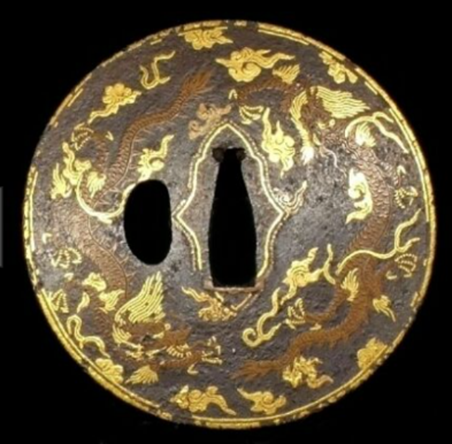
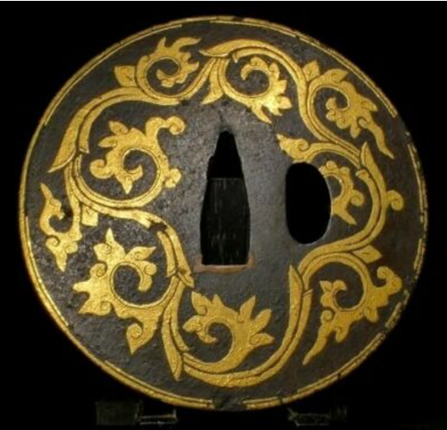
-
 1
1
-
 1
1
-
-
Oh and as Ian pointed out, there's definitely some influences from Tibet (and I'll add Vietnam as well) in some Nanban tsuba.
"Nanban" is referencing a giant cross-cultural meeting point and sharing of ideas. There are a quite a few tsuba examples that get really difficult to pin down to a specific area of production because there are elements of multiple cultural motifs and techniques all wrapped up in the same tsuba. There's tons to sort through and lots to learn about.
Here's a late Ming period (1500s-1600s), decorative horse saddle side plate:
more info on it here: https://mandarinmansion.com/item/tibetan-style-pierced-saddle-plate
-
 2
2
-
-
Ian here's a few examples of tsuba made by Chinese smiths living and working in Nagasaki (Edo period).
I know of one "school" of these Chinese smiths, called "Kiyou-Toujin", and they had a very distinct style to them:
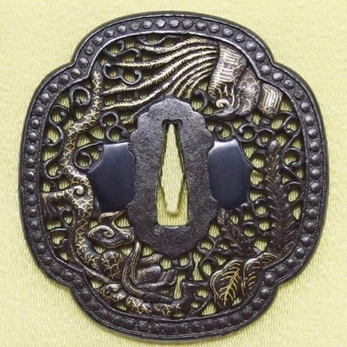
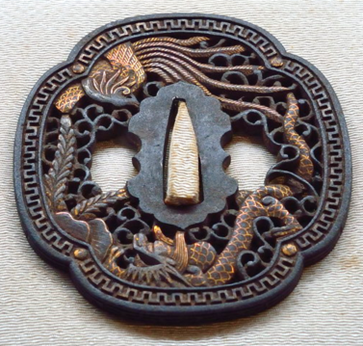
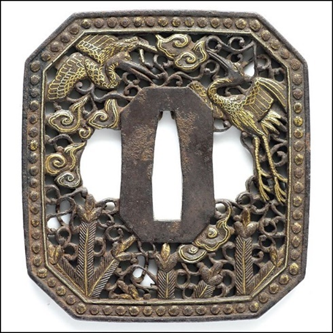
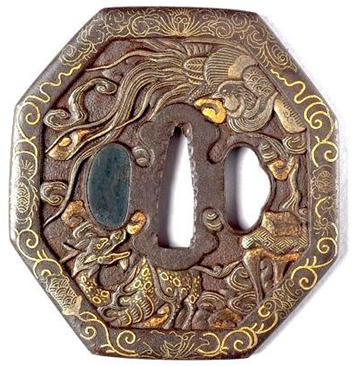
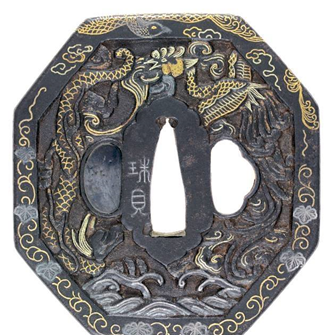
-
 2
2
-
-
Thanks for sharing those images and info Kirill

I looked up some info on Ming period Chinese swords (years 1368-1644), and found quite a variety of blade styles and guard styles.
Lots of images and info here:
https://greatmingmilitary.blogspot.com/2015/06/swords-and-sabres-of-ming-dynasty.html
Interesting that there were several flat "wan-gata" type guards that have a raised, angled rim, rather than a full bowl shape.
Like the one Kirill posted:
And here's a nice article on the Japanese exported swords and Japanese-style swords made in China during that time period.
https://mandarinmansion.com/item/chinese-woyaodao
It's called the woyaodao (倭腰刀), literally: "Japanese styled waist-worn saber".
Again, thanks to Kirill for the initial info

-
Dan: we would need some better images of yours to get a better sense.
Roger:
12 hours ago, roger dundas said:I personally love the uncertainty of it all eventually leading to a certainty and an understanding.
Me too... it's lots of fun doing this sort of hunting for clues and evidence

I started looking at the signed one more closely, and there's definitely some suspect areas on the ura side...
1- Some weird streaked pitting on one of the dragon heads, and an incomplete dragon horn tip.
2- some incomplete tail fin spines on the left tail:
3- The left side of the pearl and both teeth of the left dragon also look flawed
It would be pretty hard to explain all those if it was all done by hand from start to finish.
Maybe the pearl and tooth could have been the result of a flake/chunk of material that broke away or some rust damage... but in the context of the other flawed areas, and having no signs of major rusting anywhere else, plus the near identicalness to the other "twin" tsuba... I'm leaning toward the idea that these are all examples of some type of casting flaw.
So, I'm thinking this is a cast tsuba that was finished by hand to hit a higher standard of finish.
-
 2
2
-
-
Yours is definitely different from the rest Dan.
Here's the two Dale and I posted, but side by side now:
The one key difference that I can spot is the treatment of the dorsal fins (above and below the hitsu-ana).
The one on the left seems to have a few "voids" in the pattern.
Maybe I need to reconsider my earlier "hand worked" statement... unless the one on the right was initially cast then worked by hand afterward to reach a higher standard of finish. Maybe that's why the one on the right got a signature?

-
Finally, a genuine one of these that isn't a mass produced casting!
I was starting to wonder if an original hand-worked example ever existed at all. lol
Strange that the top kanji of the mei seems like it was purposefully rubbed out though...
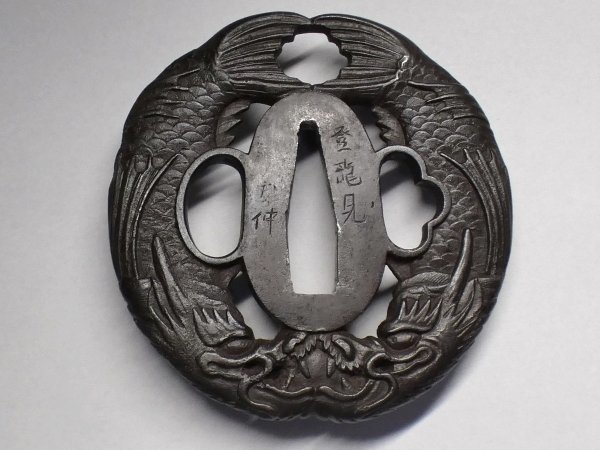
-
 1
1
-
-
Dan, I think that's one single dragon wrapped around the face of the tsuba, and its body is disappearing and reappearing through clouds.
The lower right part is the tip of the dragon's tail, with this kind of tail tip:
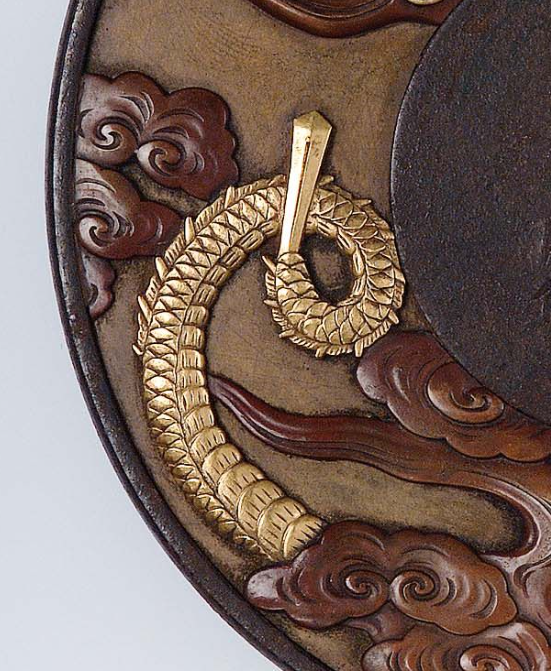
-
Hi Ian,
I'm sure you're right that war trophies would have been taken from those two invasions of Korean.
That sparked me to do some thinking and some digging about when this nanban influence all started and when the Japanese would have started making their own...
Prior to the invasions of Korea, there was extensive trade with China and Korea throughout the Momoyama period which predates the invasions.
https://www.metmuseum.org/toah/hd/momo/hd_momo.htm
Extensive trade was established in the early 1400s:
"A milestone for the subsequent cultural developments was that (Ashikaga) Yoshimitsu appointed himself as a tributary vassal of the second emperor of the Ming Dynasty in the eighth year of Ôei (応永, 1401). With this, three years later the official trade was able to be launched between Japan and Ming-China, which would last until the mid-16th century. "
That quote is from Sesko: https://markussesko.com/2014/10/11/historic-overview-of-aesthetic-requirements-for-a-tsuba-part-i/
Here's an interesting (and relatively brief) scholarly article about international Japanese trade titled "Japan and the World 1450-1770 - Was Japan a closed country?":
According to that article, mainland art, religion and philosophy was still entering Japan and had major influences throughout the early Edo Tokugawa period.
And just as a side note: Chinese painting had a massive influence on the Japanese aesthetic at the time of the momoyama period.
For example, every Kaneie tsuba landscape scene was inspired by Chinese "sansui" (shan shui) landscape paintings.
So the influences and thirst for Chinese aesthetics was already well established prior to the invasions into Korea.
Also Korean sword guards on "Hwando (military swords) from the Joseon Dynasty (15th to 19th centuries)" -Met museum, looked more like these two:
So, they were not of the most common nanban style, which in my observations, is more heavily influenced by Chinese aesthetics.
Korea favored a large oval seppa-dai, not the narrow rectangular seppa-dai.
They also frequently used a key pattern inlay around the mimi, and favored silver, rather than gold inlay.
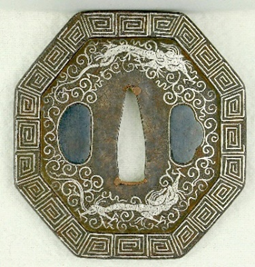
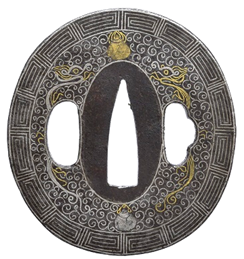
Here are two Edo period Korean guards which seem to have taken on a more typical Chinese "nanban style" influence.
(note that for the 2nd one: the thick gold overlay on the mimi and the expanded kogai-hitsu-ana were done later in Japan):
A side note observation: it's interesting that these two have a mimi with a "concavely dished" scallop pattern... which is very rare in nanban tsuba. The scallop-edged nanban mimi is usually made up of convex rounds.
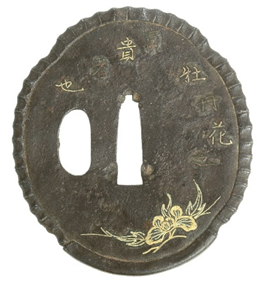
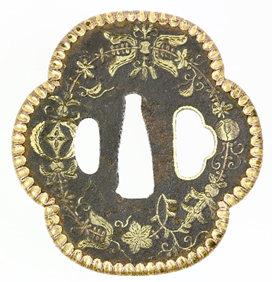
So in summary, from a historical standpoint, the trade-related nanban influence would pre-date the invasions of Korea, and could go as far back as the early to mid-1400s.
Also, I didn't mention it earlier, but there was also a strong culture of "gifting" items (such as tsuba) during all these international trades. That's why the Dutch VOC company had commissioned the production of Asian export tsuba made in Sri Lanka. And the Europeans didn't arrive until 1543, so it was the Chinese who had the longer period of influence.
As Ian pointed out, there would likely have been a surge in the influence of continental tsuba aesthetics after the invasions of Korea.
And an increase in Japanese manufacture would naturally follow an increase in the demand from their patrons.
I suspect the increased demand, in conjunction with a more tightly controlled flow of international trade during the Tokugawa period, would favor either the "beginning of" or "increase in" the Japanese production of nanban style tsuba.
Anyone else have some thoughts on the timing of things, and who made what and when?
-
 2
2
-
 1
1
-
-
Colin, those two mimi certainly look similar, and I like the funky use of some sort of bean/fruit/ginger to outline the hitsu.
Initially it kind of looked like hot peppers to me... but that's a really rare motif.
I suspect It's more likely the ginger motif that is used extensively in Japanese tsuba:
You can see some "undulations" in the outline of the shape on the right side of your tsuba, which would suggest ginger rather than a smooth bean or pepper:
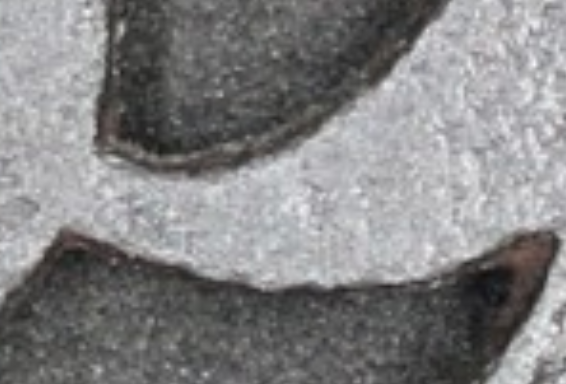
I have also heard about this link between the Sado island school and the grooved "twisted rope" mimi, but it seems there are quite a few different schools/makers who also made the twisted rope mimi.
I have yet to see a signed Sado (Sashu ju) tsuba with this style of mimi (but admittedly, I also haven't been looking too hard for one either).
Does anyone out there have a signed example they can post a pic of?
-
 1
1
-
 1
1
-
-
a real statement piece!
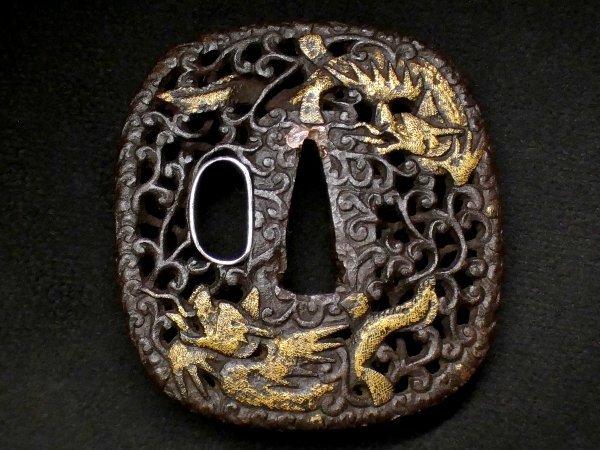

-
 2
2
-
-
At least, I'm assuming that was what you meant by "Sendai kinko"...

-
 1
1
-
-
Hey Didier,
I recently stumbled across this school's work as well.
Beautiful stuff

Here's what I managed to pull together...
Kusakari School (草刈)
Sendai in Mutsu Province
Chōsaburō (長三郎), 1st gen., was considered to be the founder of the Kusakari school, but was not a initially a kinkō artist.
(The smith/s) became kinko smiths after the influence of Masamura Shichi´emon (正村七右衛門) a local silversmith from Sendai.
This was from a translation of info somewhere online... the second sentence just started with "Became" so I don't know who was specifically trained by that silversmith.
Here's some pics:
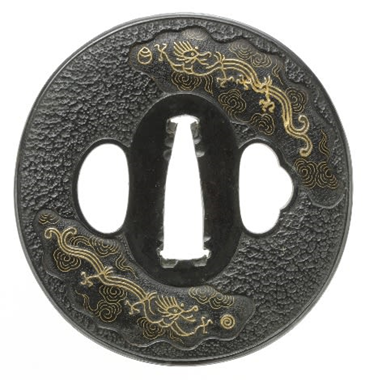
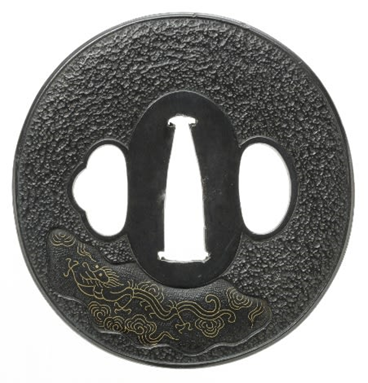
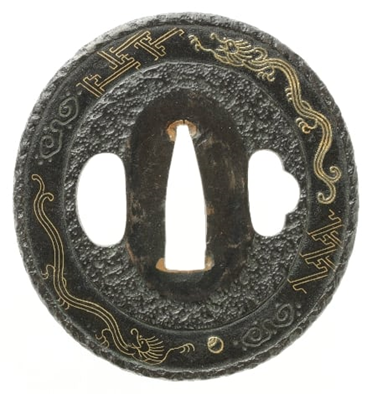
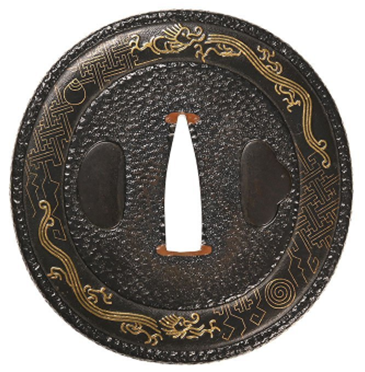
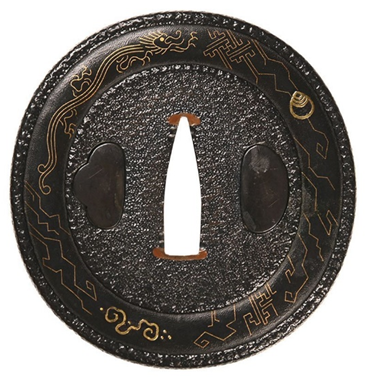
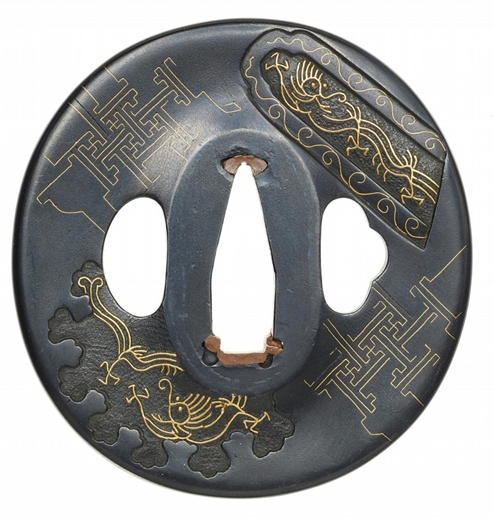
They also did a lot of fans:
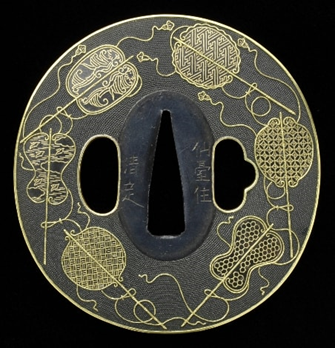
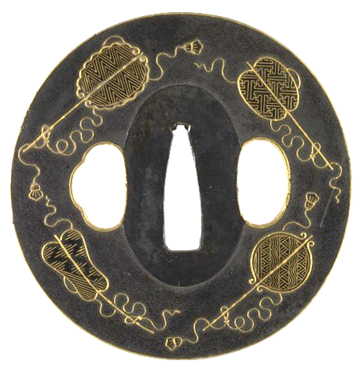
-
 2
2
-
-
Piers, your #3 looks like the myth/legend of the carp that swim through the "dragon gate" which then transforms them into dragons.
typical fish at right, gate at bottom, fish becoming more dragon like at left, full dragon at the top.
Cool motif

And your fourth one is nice example of that Japanese version of the castellated / crenellated seppa-dai tsuba.
I like how sharp the contrast is from the focused use of the gold nunome.
-
 2
2
-
-
Piers, your number 2 guard looks like a Japanese made tsuba that is paying tribute/homage to the earlier Chinese guards that had gemstones inlayed into them.
I haven't seen another like it

Here are some Chinese examples that have the stones missing:
The Chinese ones always have some type of scrolling karakusa pattern, and never have carved dragons like yours does.
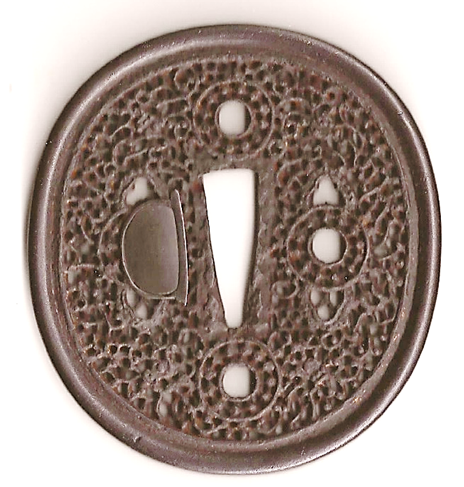
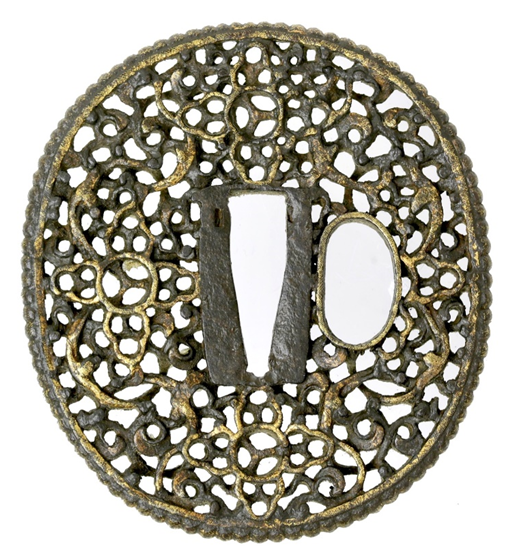
and one with:

-
 1
1
-
 1
1
-
-
Piers, thanks for sharing

The first one you posted has some really distinct (unusual?) features that are strikingly similar to this tsuba with a solid plate.
1-the dragon head
2-the dragon tail
3-the multi-ridged outline along the rounded mimi
4-the flat oval seppa-dai that has a purposeful outline just inside its outer edge
I don't have any other examples with that specific dragon head...
Interestingly enough, the solid one was attributed as being a "DUTCH EXPORT GUARD made in GALLE SRI LANKA" (for the VOC), by James McElhinney
-
 1
1
-


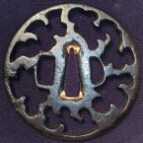
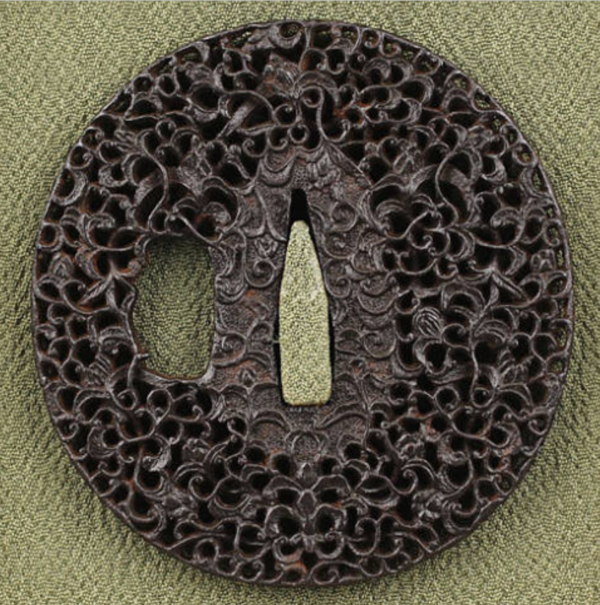
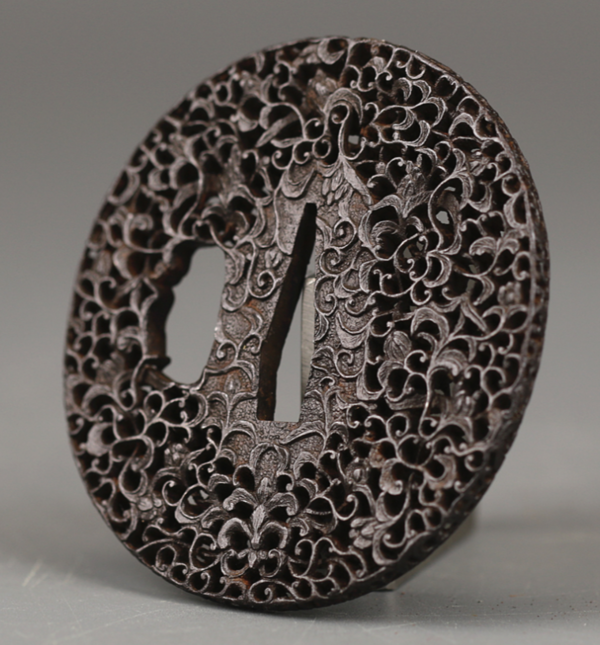
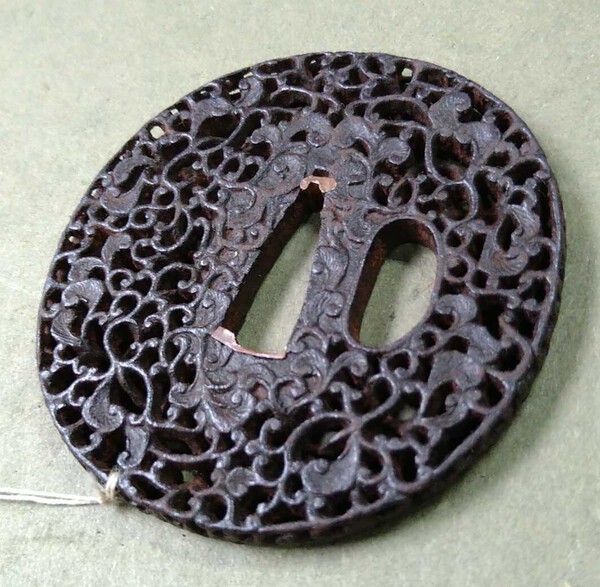
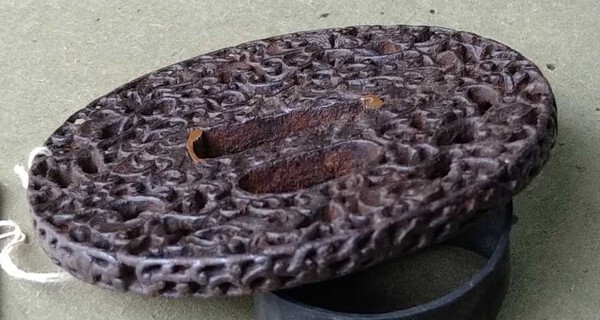
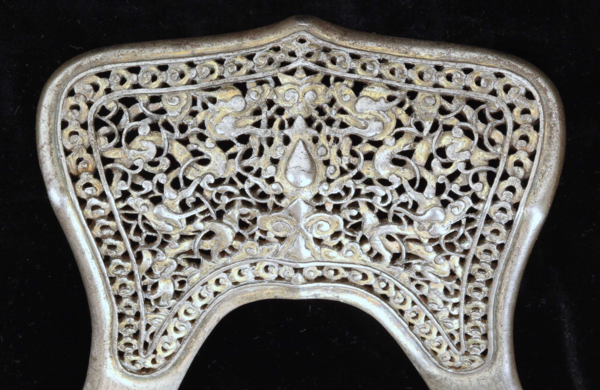
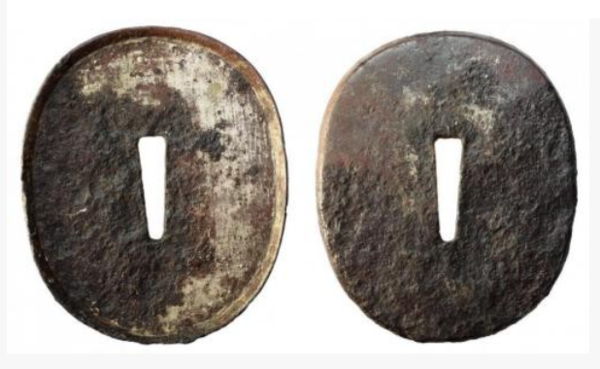
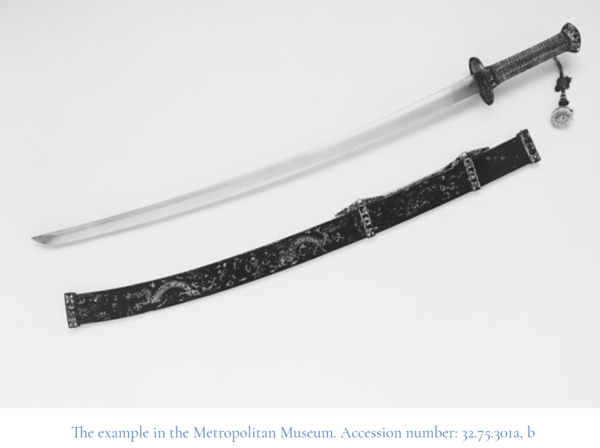
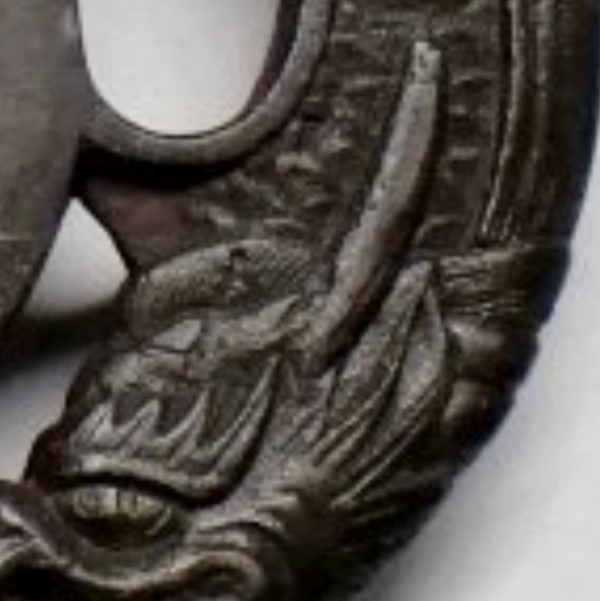
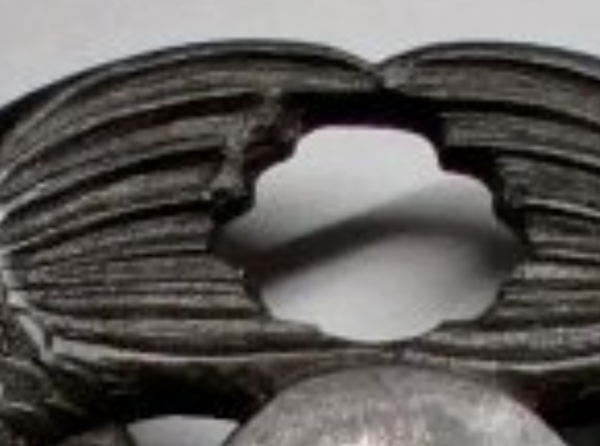
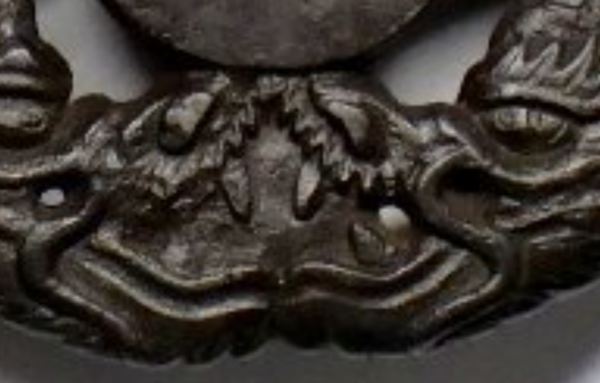
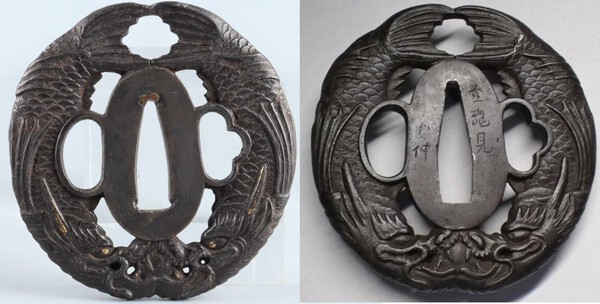
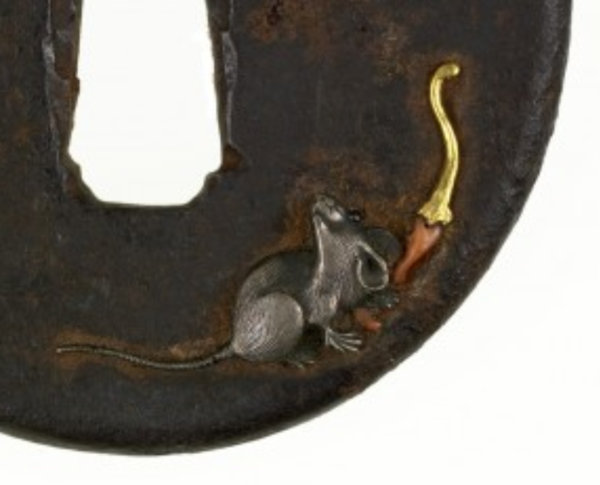
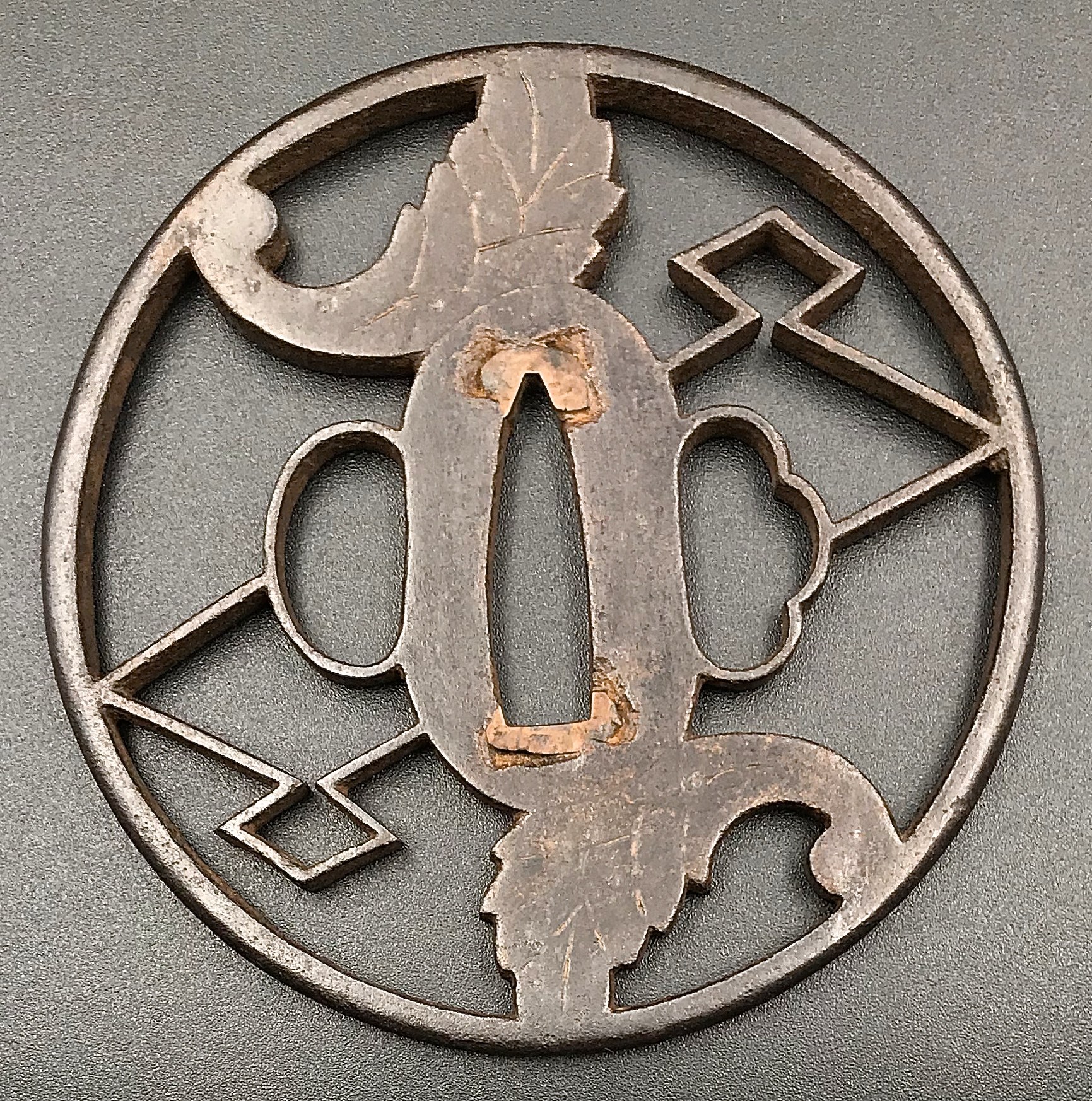
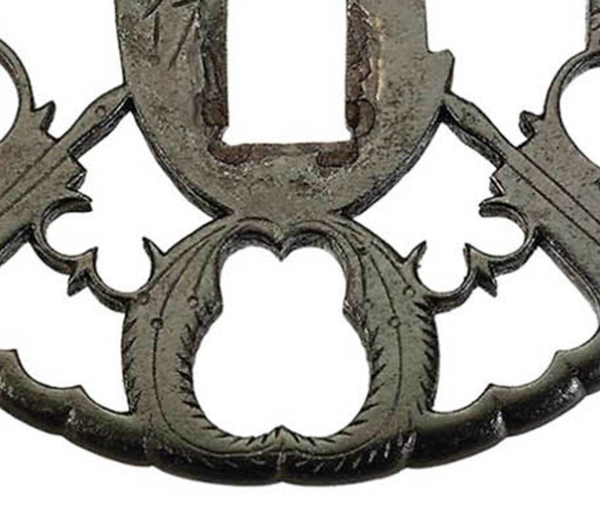
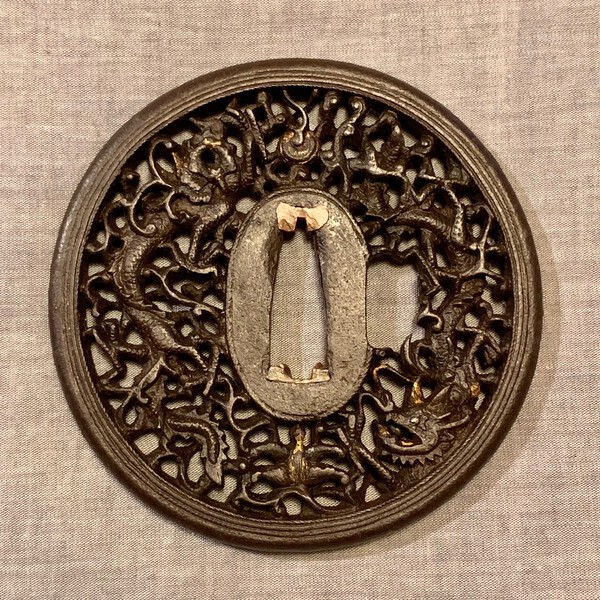
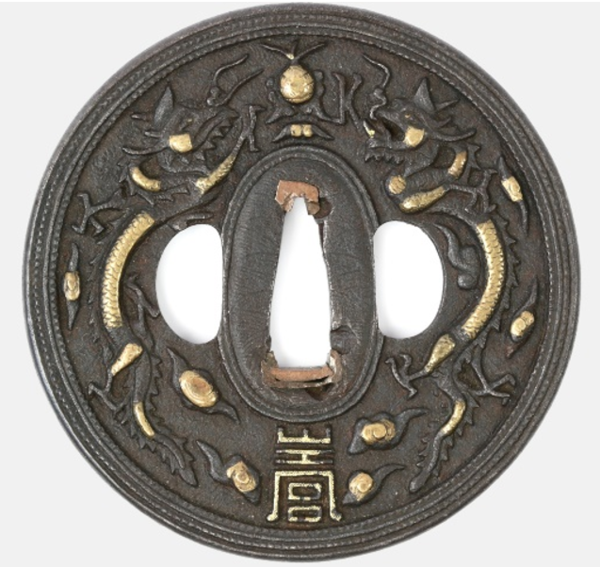
A bit rough but someone has loved it!
in Tosogu
Posted
Just to give a visual to go along with the "fugitive" nature of silver vs gold nunome, the silver does have a tendency to "travel out" from where it started on the tsuba (not my tsuba btw):